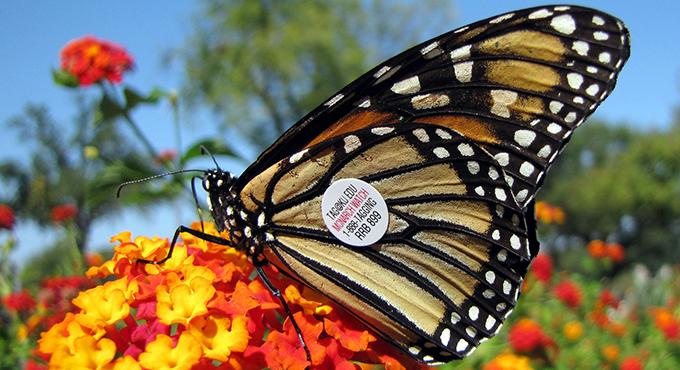
Two-thirds of papers published on field-based monarch research use citizen science data, new study finds
Annapolis, Md. — Do you need a PhD to make meaningful contributions to scientific scholarship? Not necessarily. Citizen science programs have engaged non-professionals in monarch butterfly research since the 1950s, and every year, thousands of volunteers go into the field to collect data on butterflies. However, the degree to which citizen-collected data shape our understanding of these winged insects has never been measured.
Until now.
A new study published today in the peer-reviewed journal BioScience outlines the fundamental contributions made by citizen scientists to monarch scholarship. Of the 503 monarch-focused research publications in which new results were presented from 1940 to 2014, 17 percent used citizen science data. Further, two-thirds of papers on field-based research since 2000 used citizen science data.
The study is the first to explicitly quantify the impact of citizen science on monarch research.
“Researchers cannot answer the questions we have about monarchs without deep engagement of a large network of citizen scientists,” said Dr. Leslie Ries, lead author of the paper and an ecologist at the National Socio-Environmental Synthesis Center (SESYNC) and the University of Maryland. “Citizen scientists are a crucial part of the scientific process, but their contributions do not always get the respect they deserve.”
Citizen science data have been especially critical to answering large-scale questions such as population dynamics and migration, Ries explained.
Every fall, North American monarchs fly from their northern breeding grounds to spend the winter at southern roosting sites. Monarchs are the only butterflies to make such a long, two-way migration, flying as far as 3,000 miles to reach their overwintering destinations.
Monarchs are especially vulnerable to pressures such as habitat loss and climate change, which threaten to disrupt their annual migration pattern. Understanding which regions along the monarch’s migratory path are important to population viability and what environmental factors drive their movement can inform effective conservation strategies. Citizen scientists are key to this insight.
“There are certain questions that can only be answered with large-scale and long-term data sets. And these data can only be collected with the involvement of and broad coverage enabled by citizen scientists,” said Dr. Karen Oberhauser, co-author of the paper and a conservation biologist at the University of Minnesota. “Monarch citizen science programs have done a great job taking advantage of the incredible resource that we have in all of these interested volunteers.”
Despite the incredible contributions of citizen science on monarch research, Ries and Oberhauser say the data amassed by these projects are still underused. Many citizen science data have never been used in peer-reviewed publications, and most have been used no more than a handful of times. This is likely because many of the data were unknown or unavailable to scientists until recently, but partnerships such as MonarchNet and the North American Butterfly Monitoring Network are changing that.
Academia has also been slow to trust citizen science data: one criticism of citizen research is that its reliability and validity cannot be controlled as it is in the scholarly sector.
Such skepticism is unwarranted, Oberhauser says.
“Who collects field data in scientific studies? It’s often undergraduate researchers who are paid 10 dollars an hour—they aren’t necessarily going to do a better job than somebody who is volunteering their time and has a vested interest in the phenomenon they are studying,” she commented. “Citizen scientists are equally as diligent about the accuracy of their data. They want to do a good job because they care about the work.”
The authors found that volunteers spent more than 72,000 hours collecting data useful for monarch research in 2011 alone. Based on the Independent Sector’s estimate of the average value of a volunteer hour, the estimated annual value of this citizen science service is more than $1.6 million.
This estimate only begins to hint at the true value of citizen scientists—but makes a case for the funding of citizen science programs.
“There’s not a lot of money out there to help support citizen science programs, yet they are becoming more and more critical,” said Ries. “One of our goals for this paper was to validate their role in scientific research, and the numbers are clear: Many questions critical to our understanding of monarch biology are basically impossible to answer without citizen scientists.”
This work was supported in part by the U.S. Geological Survey’s Powell Center for Analysis and Synthesis, the U.S. Forest Service International Programs, and National Science Foundation grants no. DBI-1147049 and no. DBI-1052875 awarded to National Socio-Environmental Synthesis Center (SESYNC).
The research paper, “A Citizen Army for Science: Quantifying the Contributions of Citizen Scientists to our Understanding of Monarch Butterfly Biology,” Leslie Ries and Karen Oberhauser, was published online April 8, 2015, in the journal BioScience.
Media Contact
Melissa Andreychek
mandreychek@sesync.org
(410) 919-4990
###
The National Socio-Environmental Synthesis Center, funded through an award to the University of Maryland from the National Science Foundation, is a research center dedicated to accelerating scientific discovery at the interface of human and ecological systems. Visit us at www.sesync.org and follow us on Twitter at @SESYNC.
Top photo: A monarch butterfly tagged by the citizen science project Monarch Watch, courtesy Katja Schulz via Flickr/Creative Commons.